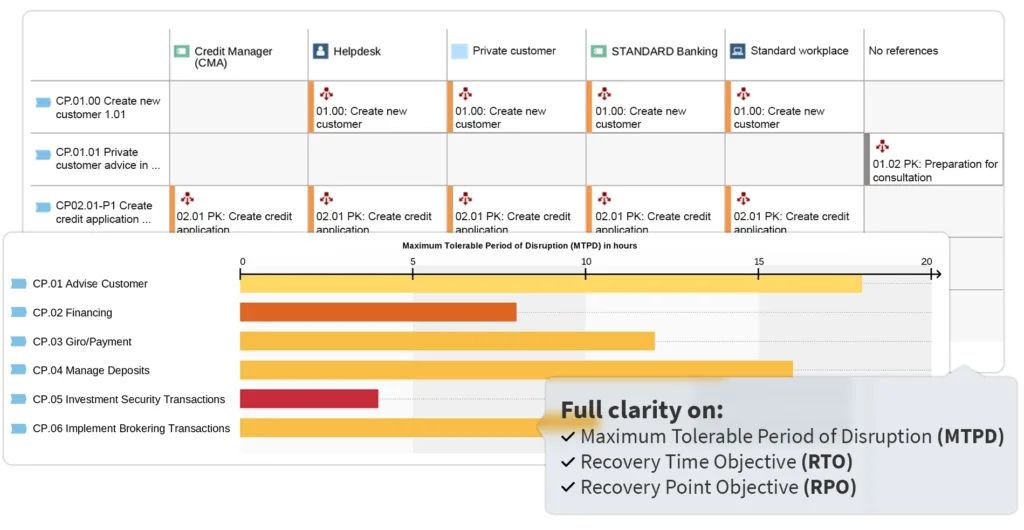Found this helpful? Share it with peers.
Introduction
From supply chain failures and system outages to cyberattacks and power disruptions, organizations face a wide range of events capable of halting operations. If your company had to stop functioning tomorrow, would you know which processes to restore first? And how quickly could you recover before the impact becomes unacceptable?
A Business Impact Analysis (BIA) provides the structured approach needed to answer these questions. More than a risk assessment tool, it is the foundation of Business Continuity Management (BCM) and a strategic enabler for operational resilience. It helps organizations understand what is truly critical, how long they can tolerate a disruption, and what resources are essential for recovery.
This guide explains the fundamentals of BIA, the steps for a successful implementation, common challenges, and how a GRC platform can make the process more reliable and efficient.
What is a Business Impact Analysis (BIA)?
A Business Impact Analysis is a structured method for evaluating how disruptions affect an organization’s essential functions, processes, systems, and dependencies. Its goal is to determine:
-
Which processes are critical
-
How disruptions affect them over time
-
What level of downtime is tolerable
-
What resources are needed to maintain or restore operations
A BIA assumes two fundamental realities:
-
Business processes depend on each other – a failure in one area can create cascading effects.
-
Not all processes are equally important – some must resume quickly to avoid unacceptable damage.
During the analysis, organizations assess potential financial, operational, legal, reputational, and safety impacts. They also define core business continuity metrics:
-
Maximum Tolerable Period of Disruption (MTPD) – the longest acceptable downtime
-
Recovery Time Objective (RTO) – target time to restore operations
-
Recovery Point Objective (RPO) – acceptable level of data loss
A key part of the BIA is uncovering dependencies, including IT systems, facilities, personnel, suppliers, and other internal processes. These insights form the basis for continuity strategies and resource prioritization.
Why is BIA Important?
Reacting spontaneously in a crisis often leads to rushed or inconsistent decisions, reducing their effectiveness. To mitigate risks and minimize disruptions, companies need well-defined strategies in place before an emergency occurs.
The Business Impact Analysis helps organizations identify vulnerabilities and potential risks early, enabling targeted preventive measures. It forms the foundation for contingency planning, strengthens disaster recovery efforts, and ensures operational continuity.
BIA serves as the foundation for effective Business Continuity Management (BCM), proactively managing risks and enhancing the company’s resilience to disruptions.
Additionally, the analysis provides clear, data-driven recommendations to protect critical processes and resources, ensuring a structured and effective response when challenges arise.
Hint: Discover our integrated solution for Business Continuity Management.
How to Conduct a Business Impact Analysis
A successful BIA follows a structured sequence of steps. Below is an enhanced implementation framework that balances practicality with depth.
1. Preparation and Scoping
A well-scoped BIA ensures accuracy without overwhelming teams.
Define the Scope
Decide whether the BIA will cover the entire organization or selected critical units. Prioritizing time-sensitive processes accelerates BCM maturity.
Build an Interdisciplinary Team
Include representatives from IT, operations, finance, HR, legal, production, and other relevant domains. Each contributes insights that help complete the impact picture.
2. Identifying Critical Business Processes
Not all processes require the same level of analysis. Overloading the BIA with too many items slows progress.
Focus on processes that:
-
Are essential for delivering key services
-
Cause financial or regulatory impact if disrupted
-
Affect customers or supply chain partners
-
Support critical IT or operational functions
This ensures high-value outputs and efficient use of time.
3. Assessing the Impact of Disruptions
For each critical process, assess the consequences across predefined impact categories:
-
Financial losses
-
Operational limitations
-
Regulatory or compliance implications
-
Reputational damage
-
Health and safety risks
Use a standard scoring model (e.g., low to very high) to quantify impacts objectively.
Incorporate the time component: damage often escalates as downtime increases.
4. Defining Key Continuity Metrics
These metrics guide recovery strategies and decision-making:
Accurate definitions are crucial for designing continuity plans and resource allocation.
5. Identifying Resource and Dependency Requirements
Disruptions often occur not because a process fails, but because a dependency becomes unavailable.
Map all required resources:
-
IT systems and applications
-
Facilities and infrastructure
-
Key personnel and competencies
-
Suppliers and external partners
-
Other internal processes
Leveraging information from existing systems like ISMS and business process management tool helps provide a comprehensive view of all dependencies.
6. Reporting, Validation, and Communication
Compile the findings into a report and present key insights to decision-makers and relevant teams. The data should be seamlessly integrated into BCM to refine strategies, strengthen measures, and enhance contingency planning.
Common Challenges in BIA (and How to Avoid Them)
Even well-designed BIAs face obstacles. These are the most frequent—and how to address them:
1. Poor Data Quality
Incomplete or outdated information leads to flawed conclusions.
Solution: establish regular validation cycles and centralize data sources.
2. Limited Resources and Time
Manual BIAs require significant effort and coordination.
Solution: streamline workflows and focus on the most critical processes first.
3. Siloed Information
Departments often hold isolated data, making dependencies unclear.
Solution: use cross-functional workshops or integrated tools to consolidate insights.
4. Rapidly Evolving Business Environments
Frequent organizational changes make BIA results obsolete quickly.
Solution: treat the BIA as a living document with scheduled updates.
5. Lack of Adoption
If perceived as theoretical, BIA results may not influence real decisions.
Solution: frame outputs in business terms—impact, cost, downtime, regulatory exposure.
Hint: Self-check your BCM preparedness! Use our free checklist to identify gaps, verify key tasks, and strengthen your business resilience.
How GRC Tools Support an Effective BIA
A modern GRC solution like ADOGRC enhances the BIA process by addressing its typical challenges:
Reliable, Centralized Data
Consolidates processes, dependencies, systems, and resources in one platform.
Efficient Use of Resources
Workflows, templates, and automation reduce manual effort and standardize assessments.
Dependency Visualization
Graphical maps reveal critical paths and interconnections across IT, operations, and suppliers.
Adaptability and Continuous Updates
Easy updates ensure the BIA remains relevant as risks, systems, or regulations evolve.
Improved Adoption
Clear dashboards and KPIs make results actionable and understandable, improving stakeholder engagement.

Understand the impact of disruptions: A Business Impact Analysis in ADOGRC uncovers vulnerabilities, ranks critical areas by urgency, and helps prioritize the highest risks to minimize disruptions.
Summary
A well-executed Business Impact Analysis is essential for strengthening business continuity and building organizational resilience. By identifying critical processes, quantifying impacts, and mapping resource dependencies, companies gain the insights needed to prepare for disruptions and recover efficiently.
With the support of a GRC tool like ADOGRC, organizations can conduct BIAs more accurately, integrate results seamlessly into BCM, and ensure continuity strategies remain aligned with real operational needs.




